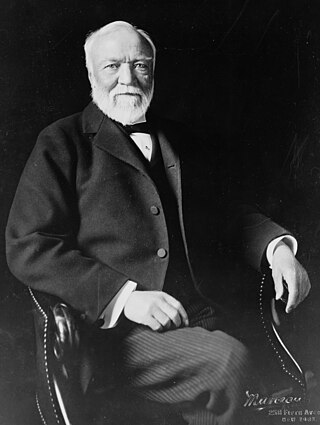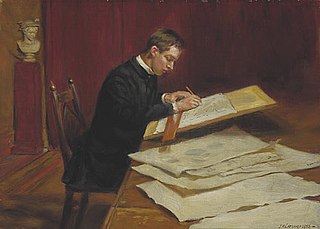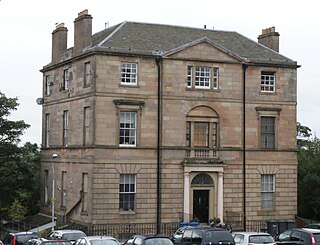
Andrew Carnegie was a Scottish-American industrialist and philanthropist. Carnegie led the expansion of the American steel industry in the late 19th century and became one of the richest Americans in history. He became a leading philanthropist in the United States, Great Britain, and the British Empire. During the last 18 years of his life, he gave away around $350 million, almost 90 percent of his fortune, to charities, foundations and universities. His 1889 article proclaiming "The Gospel of Wealth" called on the rich to use their wealth to improve society, expressed support for progressive taxation and an estate tax, and stimulated a wave of philanthropy.

Fife is a council area, historic county, registration county and lieutenancy area of Scotland. It is situated between the Firth of Tay and the Firth of Forth, with inland boundaries with Perth and Kinross and Clackmannanshire. By custom it is widely held to have been one of the major Pictish kingdoms, known as Fib, and is still commonly known as the Kingdom of Fife within Scotland. A person from Fife is known as a Fifer. In older documents the county was very occasionally known by the anglicisation Fifeshire.

Dunfermline is a city, parish and former Royal Burgh, in Fife, Scotland, on high ground 3 miles (5 km) from the northern shore of the Firth of Forth. The city currently has an estimated population of 58,508. According to the National Records of Scotland, the Greater Dunfermline area has a population of 76,210.

Kirkcaldy is a town and former royal burgh in Fife, on the east coast of Scotland. It is about 11.6 miles (19 km) north of Edinburgh and 27.6 miles (44 km) south-southwest of Dundee. The town had a recorded population of 49,460 in 2011, making it Fife's second-largest settlement and the 12th most populous settlement in Scotland.

Inverkeithing is a port town and parish, in Fife, Scotland, on the Firth of Forth. A town of ancient origin, Inverkeithing was given royal burgh status during the reign of Malcolm IV in the 12th century. It was an important center of trade during the Middle Ages, and its industrial heritage built on quarrying and ship breaking goes back to the 19th century. In 2016, the town had an estimated population of 4,890, while the civil parish was reported to have a population of 8,090 in 2011.

Fife Constabulary was the territorial police force responsible for the Scottish council area of Fife.

Sir Robert Stodart Lorimer, KBE was a prolific Scottish architect and furniture designer noted for his sensitive restorations of historic houses and castles, for new work in Scots Baronial and Gothic Revival styles, and for promotion of the Arts and Crafts movement.

Louise Whitfield Carnegie was the wife of Scottish-American industrialist and philanthropist Andrew Carnegie.

Dunfermline City Chambers is a municipal facility at the corner of Bridge Street and Kirkgate in Dunfermline, Fife. The building, which serves as home to the local area committee of Fife Council, is a Category A listed building.

Pittencrieff Park is a public park in Dunfermline, Fife, Scotland. It was purchased in 1902 by Andrew Carnegie, and given to the people of Dunfermline in a ceremony the following year. Its lands include the historically significant and topologically rugged glen which interrupts the centre of Dunfermline and, accordingly, part of the intention of the purchase was to carry out civic development of the area in a way which also respected its heritage. The project notably attracted the attention of the urban planner and educationalist, Patrick Geddes.
The Carnegie Hero Fund Trust is a Scottish charity. It was established in 1908 as a British extension to the Carnegie Hero Fund Commission which had been founded in 1904 in Pittsburgh, Pennsylvania. The Trust was founded upon a financial endowment from the Scottish philanthropist and steel magnate Andrew Carnegie. The purpose of the Trust is to provide payments to individuals who have been injured or financially disadvantaged as a result of undertaking an act of heroism or in fatal cases to provide for the family or other dependants. This has continued to be the aim of the Trust which each year considers around twelve cases of heroism within a geographical area encompassing Great Britain, Ireland, the Channel Islands and the surrounding territorial waters.

Abbot House is the oldest secular building in Dunfermline, Scotland. Lying in the shadow of Dunfermline's great abbey church, the core of the building is 16th-century. A heritage centre until August 2015, the centre closed following failed attempts by Abbot House Heritage Centre Trust to find alternative funding.

Viewfield House is a large square stone built three storey Palladian villa in Dunfermline, Fife, Scotland. It is a category B listed building.
James Campbell Walker was a Scottish architect in the 19th century, practising across the country and specialising in poorhouses and schools. His main claim to fame is in having designed Dunfermline Carnegie Library, the world's first Carnegie library, in Andrew Carnegie's home town of Dunfermline.

The Dunfermline Carnegie Library opened in Dunfermline, Scotland, on 29 August 1883 and was the world's first Carnegie Library funded by the Scottish-American businessman and philanthropist Andrew Carnegie. It was designed by Edinburgh architect James Campbell Walker who also designed the nearby Dunfermline City Chambers. Andrew Carnegie donated £8000 to building and stocking what would be the first of over 2,500 Carnegie Libraries. The library was made a Category B listed building in 1971.

Halbeath is a village northeast of Dunfermline, Fife, Scotland. It derives its name from the Gaelic choil beath, which means "wood of birches", and began as a colliery village. In the summer of 1789, a coal pit was sunk at Halbeath, two and a half miles northeast of Dunfermline, and by 1821, 841 people were reported to be living in the village.
McLean Primary School is located in the centre of Dunfermline, Fife. The head teacher is Carol Newton. Pupils from the school progress onto Queen Anne High School. The building is a category C listed building.

Carnegie Hall is an Art Deco theatre located in Dunfermline, Fife, Scotland. It was named after the industrialist and philanthropist Andrew Carnegie, who was born in Dunfermline. Designed by architects Muirhead and Rutherford, it was officially opened in 1937 and was designated a Category B listed building in 1993.

Lilias Adie was a Scottish woman who lived in the coastal village of Torryburn, Fife, Scotland. She was accused of practising witchcraft and fornicating with the devil but died in prison before sentence could be passed. Her intertidal grave is the only known one in Scotland of an accused witch – most were burned.

















